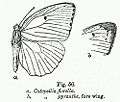Catopsilia florella
Catopsilia florella, the African migrant, African emigrant, or common vagrant, is a butterfly of the family Pieridae. It is found in Africa (including Madagascar) and the Canary Islands. Like Catopsilia pomona, this species also has a habit of migration.[2]
| Catopsilia florella | |
|---|---|
_male.jpg) | |
| Male, Ghana | |
_female.jpg) | |
| Female Aburi Botanical Gardens, Ghana | |
| Scientific classification | |
| Kingdom: | Animalia |
| Phylum: | Arthropoda |
| Class: | Insecta |
| Order: | Lepidoptera |
| Family: | Pieridae |
| Genus: | Catopsilia |
| Species: | C. florella |
| Binomial name | |
| Catopsilia florella | |
| Synonyms | |
| |
Many early authors mentioned the presence of this species in Asia;[3][4] but those were probably due to confusion arises as Catopsilia pyranthe females exhibit a lot of seasonal variations.[5] Catopsilia florella is not included as a species in India in any recent checklists.[6]
The wingspan is 54–60 mm for males and 56–66 mm for females. Adults are on wing year-round. From South Africa, adults migrate from summer to autumn. They fly in a north-eastern direction.[7]
The larvae feed on Senna occidentalis, Senna septentrionalis, Senna petersiana, Senna italica, Cassia javanica, and Cassia fistula.[8]
Gallery


_(16296693588).jpg)
_mating_migrant_male_(l)_dry_season_female_(r).jpg) mating migrant male (l) & dry season female (r), Gambia
mating migrant male (l) & dry season female (r), Gambia
| Wikimedia Commons has media related to Catopsilia florella. |
| Wikispecies has information related to Catopsilia |
References
- Catopsilia florella at Markku Savela's Lepidoptera and Some Other Life Forms
- Larsen, T. B. (1992). "Migration of Catopsilia florella in Botswana (Lepidoptera:Pieridae)". Tropical Lepidoptera. 3 (2): 11. Retrieved 4 May 2018.
- Bingham, C.T. (1907). The Fauna of British India, Including Ceylon and Burma. II (1st ed.). London: Taylor and Francis, Ltd. pp. 223–224.
- Larsen, T. B. (1977). "Butterfly Migrations in the Nilgiri Hills of South India (Lepidoptera: Rhopalocera)". The Journal of the Bombay Natural History Society. 74: 546–549. Retrieved 4 May 2018.
- Swinhoe, Charles (1905–1910). Lepidoptera Indica. Vol. VII. London: Lovell Reeve and Co. pp. 90–94.CS1 maint: date format (link)
- Varshney, R.; Smetacek, P. A Synoptic Catalogue of the Butterflies of India (2015 ed.). New Delhi: Butterfly Research Centre, Bhimtal and Indinov Publishing. p. 67.
- Woodhall, Steve (2005). Field Guide to Butterflies of South Africa. Cape Town, South Africa: Struik. ISBN 978-1-86872-724-7.
- Martiré, J. & Rochat, D. (2008). Les Papillons de la Réunion & leurs chenilles. Biotope.